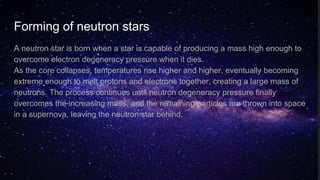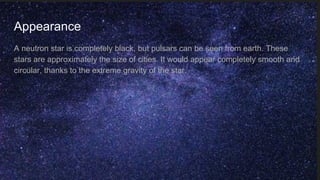Neutron stars basics
- 1. Neutron stars How they work
- 2. Introduction Neutron stars are the remains of dead stars approximately four to eight times the mass of the sun. They are extremely dense objects about the size of a city, compromising almost entirely of neutrons. These stars have an immense gravitational pull and can spin hundreds of times every second.
- 3. Forming of neutron stars A neutron star is born when a star is capable of producing a mass high enough to overcome electron degeneracy pressure when it dies. As the core collapses, temperatures rise higher and higher, eventually becoming extreme enough to melt protons and electrons together, creating a large mass of neutrons. The process continues until neutron degeneracy pressure finally overcomes the increasing mass, and the remaining particles are thrown into space in a supernova, leaving the neutron star behind.
- 4. Lifespan Over time, the spinning speed of a neutron star steadily decreases. This is an extremely slow process, occurring over thousands of years. Neutron stars cool down through a number of complex processes, such as URCA and modified URCA processes, photon cooling, and bremsstrahlung processes. These each occur over different parts of the star’s life. Neutron stars can live longer than most other stars in the universe.
- 5. Properties of a neutron star Gravity It’s huge, dense mass means a neutron star has a very strong gravitational pull about 2,000,000,000,00 times stronger than earth. An object must accelerate up to nearly half the speed of light to escape it’s pull. Radiation Neutron stars produce radiation known as pulsars, which are caused by particles moving at close to the speed of light. Radiation is one of the primary ways currently used to detect neutron stars from earth.
- 6. Properties of a neutron star Magnetic field A neutron star has one of the strongest magnetic fields out of most objects in the universe. It is capable of causing unique particle interactions, such as the merging and splitting of photons. It is millions of times stronger than magnetic fields on earth. Structure A neutron star is composed predominantly of neutrons, with different properties and molecular structures deeper into the neutron star. Closer to the core, at extreme pressure, quark-gluon plasmas and other unusual particles are able to form.
- 7. Properties of a neutron star Density Neutron stars have very high densities, with a single teaspoon worth of material roughly equal to a billion tons. An average neutron star is about one and a half solar masses, forced inside the space of a small city. Temperature The temperature of a neutron star begins extremely high, at about 10,000,000,000,000 degrees kelvin, cooling in a few seconds to 10,000,000,000,00, and then in a few years to 10,000,000 degrees kelvin. Over a very, very long time, the temperature will eventually cool down.
- 8. Composition A neutron star is predominantly composed of neutrons, with a few electrons and protons within some of the layers of the star. A range of particles such as pion condensates, delta isobars, and quark-gluon plasmas can be found within the inner layers of the star where temperatures are high enough. A neutron star emits neutrinos and other particles through pulsars, which can be detected from earth. A neutron star can also have material orbiting it in the form of stellar wind.
- 9. Examples - PSR J0108-1431, aged 166 million years - PSR B1257+12, aged 1-3 billion years - PSR JO348+0432, aged 26,000,000,000 years - PSR B1919+21, aged 16 million years
- 10. Discovery of neutron stars - Walter Baade and Fritz Zwicky first proposed the existence of neutron stars, in december 1933, at a meeting with physicists. - 1965, Antony Hewish and Samuel Okoye found a strange source of radio brightness in space. - In 1967, Franco Pacini suggested the search for neutron stars should focus on discovering the electromagnetic waves caused by the rapid spinning of the star. Antony and Jocelyn Bell discovered the radio emissions of a pulsar from a neutron star. - In 1974, Joseph Taylor and Russell Hulse discovered the first two orbiting neutron stars.
- 11. Appearance A neutron star is completely black, but pulsars can be seen from earth. These stars are approximately the size of cities. It would appear completely smooth and circular, thanks to the extreme gravity of the star.
- 12. Some facts about neutron stars - Gravity is so great that any material impacting with a neutron star will essentially become part of the neutron star, it’s material becoming identical. - A neutron star can spin at up to nearly a quarter of the speed of light. - Neutron stars are one of the most long lasting objects in the universe. - These stars can, and have been found to have, exoplanets orbiting around them. - Neutron stars no longer generate their own heat, but last up to billions of years.
- 13. Conclusion Neutron stars are very strange and very interesting interstellar objects we are still learning new things about. They function and operate very differently from most other objects in the universe, and are still fairly mysterious.













